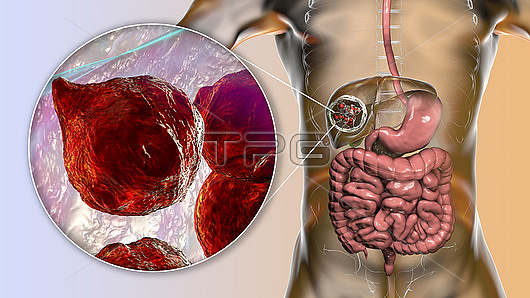
Hydatid disease in liver, cystic echinococcosis. Composite computer illustration showing Echinococcus granulosus hydatid cyst in the human liver and close-up view of larvae protoscolices inside hydatid cyst. E. granulosus is a parasitic tapeworm, also called as dog tapeworm and hydatid worm, which causes cystic echinococcosis. Humans are infected by ingestion of parasitic eggs excreted by feces of definitive host (dogs and wild carnivores), the eggs hatch in small intestine and release a six-hooked oncosphere, which in turn penetrate intestinal wall, migrate through circulatory system to other organs, mainly liver and lungs, and develop into a thick-walled hydatid cyst, which enlarges gradually, produces protoscolices and daughter cysts that fill the cyst interior. This cyst is slow-growing but can causes clinical symptoms and become life-threatening if untreated.
| px | px | dpi | = | cm | x | cm | = | MB |
Details
Creative#:
TPG31219073
Source:
達志影像
Authorization Type:
RF
Release Information:
須由TPG 完整授權
Model Release:
N/A
Property Release:
N/A
Right to Privacy:
No
Same folder images:

 Loading
Loading